The Beauty of Numbers
As a kid in school, math did not come as easily to me as the other subjects. I had to work at it. Naturally, I assumed I was bad at it, as a result.
I continued to operate under this misconception well into my thirties and early forties until I was seriously into knitting and knee deep in designing (and publishing) lace shawls and other garments where I crunched numbers daily to determine how much yarn I had left in yards by weighing it and computing the number of stitches on my needles after so many repeats, etc.
From knitting and designing knitwear to weaving, these daily mathematical gymnastics continued.
To a physicist or true mathematician, my efforts are rudimentary. For the average Jane, my non-knitting and non-weaving life requires few, if any math skills beyond simple addition and subtraction.
Before the ATM card and online banking, balancing the checkbook was the most serious application of math in my daily life.
In an odd twist of fate, I have embraced numbers and discovered now much I enjoy delving into the math of my projects.
Math is solid, certain, and reliable.
In a fluid world, it is so nice to have a constant.
A large (60-inch) Leclerc Colonial 8-shaft loom was in the garage for the last few years. In February, it left for its forever home.
In an effort to ensure its owner fell in love with it, I offered to warp the beam for her. She said she liked bright, happy colors. The rest she left up to me.
On a sunny January afternoon, I warped the beam sectionally in a striped design I came up with playing with numbers.
As a creature of habit, each of my looms has, at least, two reeds: 10-dent and 12-dent.
While I occasionally weave 8/2 tea towels with a sett of 20, my default for both 8/2 and 10/2 cotton towels is a sett of 24, depending on weave structure.
My preference for tea towels is to weave them 24-inches wide and 36-inches long under tension. If it is to become a hand towel, I weave it 40-inches long under tension.
Because I have done it so many times, I know reflexively that a sett of 24 multiplied by 24-inches is 576 ends.
Point twill has a pattern repeat of 14 (1 to 8, 7 to 2):
576 minus 2 for a floating selvage on either side is 574.
574 divided by 14 (a single pattern repeat of point twill) is 41.
This is beautiful to me.
I know every time I have a 24-inch wide warp with a sett of 24 that I will have two floating selvages and a nice even repeat of patterns across my weaving. There will be no need to center the pattern or do any other calculations.
I also know I will need exactly 41 heddles on shafts 1 and 8 and 82 heddles on each of the harnesses from 2 to 7. Period.
This is one reason I use point twill so often. The other is there are so many variations of it, I have a Pinterest board devoted exclusively to it.
For my friend and her new loom, I wanted to do something a bit simpler. She has been weaving for a while now, but this was her first floor loom. In fact, she has been weaving on a Schacht 8-shaft 25-inch table loom, which was my very first loom. She bought it from me a few years ago. (That same loom on a stand is now available for sale, if anyone is interested.)
I decided on a straight draw threading sequence (4 to 1 and repeat) with a plain twill treadling pattern (4/1, 1/2, 2/3, 3/4) using four or her eight harnesses. We also set up her treadles to reflect a walking pattern. Instead of numbering her treadles from left to right 1, 2, 3, and 4, we did 1, 3, 2, and 4. Thus, she uses a left foot/right foot motion, rather than left/left/right/right. It is not only more natural but more efficient.
In addition to enjoying my friend’s success and pleasure with her new loom, I had fun figuring out an easy to remember (for preparing a warp) sequence of numbers for stripes.
First, I wanted something that meshed seamlessly with a sett of 24.
Second, I wanted it to be evenly divisible by 8 should I do block twill.
Third, I wanted it to have lines (stripes) that were graphically interesting.
Using a total number of 24 created narrow stripes on a white background. Playing with 48 was better, but did not give me the drama I longed for. 72 looked promising…
Then, BAM.
I tweaked the numbers and got the combination I wanted: 10 - 4 - 6 - 32 - 6 - 4 - 10.
Those numbers translate as follows:
10 - (W)hite
4 - (C)olor
6 - W
32 - C
6 - W
4 - C
10 - W
72 gave me a complete 3-inch pattern repeat.
I can add any number of colors I want, and the colored stripes are perfectly centered in the white borders.
Moreover, when preparing the warp, I break the sequence down by inch, as I bundle each sett by inch when creating chains.
First inch:
10 W
4 C
6 W
4 C
Second inch:
24 C
Third inch:
4 C
6 W
4 C
10 W
Repeat until the warp is as wide as desired.
Well, my friend is now delightfully weaving away on her loom.
Last week, I finished a warp on Evangeline, the 40-inch Macomber. My plan was to dress her with fingering weight wool for a double width blanket using one of these two sets:
Unfortunately, most of my spools were loaded with remnants from past projects.
While I use a warping square, I find it is easier with more even tension if I pull from spools rather than cones on a cone holder.
Pulling from center-pull balls has been a nightmare for me. Your mileage may vary.
Instead of winding off the hand dyed 10/2 cotton from the spools, I decided to use the striped sequence to create a warp from my mismatched leftovers. To achieve the width I wanted, I supplemented with two odd hanks that were previously untouched.
To determine the length of the warp, I weighed the color, which had the least amount of yardage. Once the weight of the spool was subtracted, I had 70 grams.
70 grams of 10/2 cotton is approximately 647 yards.
How do I know?
One pound of 10/2 cotton is 4,200 yards because Google says so.
One pound is also about 454 grams.
The formula is: 454g/4200 yards X 70g/x.
If we cross multiply 4200 by 70, we get 294,000. That number divided by 464 is 647.57, which is 647 yards.
In my 72 thread pattern repeat above, 40 threads are Color and 32 are white.
647 yards divided by 40 threads tells me I can make a warp 16.175 yards long.
While I trust the math, I do not like to push things to the limit. I decided a 13-yard warp would be fine.
Using the warping square, I knocked out a 24-inch wide warp 13-yards long.
Based on the numbers, I knew I was going to have a fair amount of thread leftover, as I had computed the length of the warp using the color I had the least of.
This morning, I gathered the remnants and tried to decide what to do with them.
I weighed an empty spool.
Then I weighed each of the fifteen spools holding thread. I multiplied the weight of the empty spool times fifteen and subtracted that number from the sum of the spools with thread.
Using the same formula and process as above, I had enough thread to make a 24-inch wide warp (with a sett of 24) 7.5-yards long.
Again, acting conservatively, I made four warp chains, each comprised of six-inches and 6-yards long.
These are the four chains:
Sadly, two of these chains have knots in them that I noticed when I was well beyond the ability to fix them; however, I have saved every teeny bit of each color.
Now for the fun part: I decided to offer these chains, the entire warp of 576 ends of 10/2 cotton, 24-inches wide and 6 yards long as a free giveaway, including shipping in the US and to Canada.
All you have to do is go to the post in my Instagram featuring the photo of these four chains, follow me, and leave me a comment telling me what you would weave with this warp.
I will enter all the names into a random picker at noon (Central) on Friday, April 14, 2022 and announce the winner shortly thereafter.
Anyone interested?
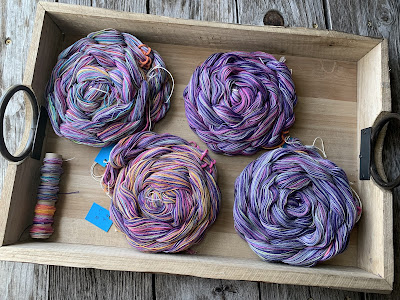

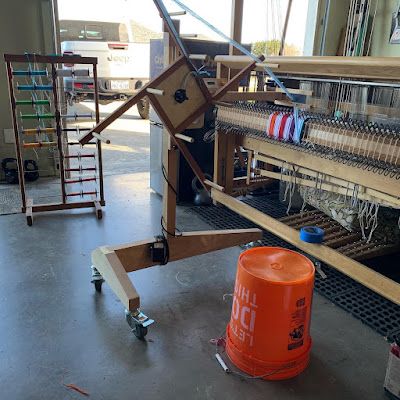


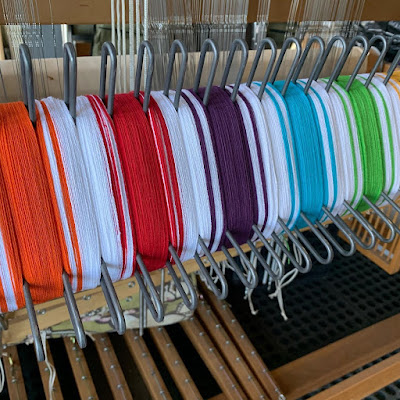

















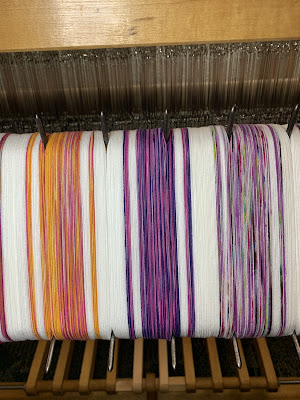






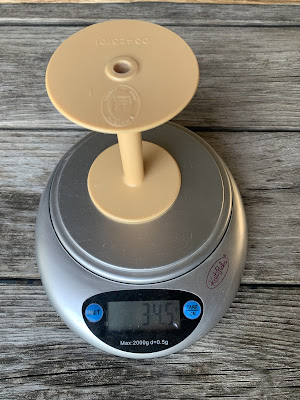




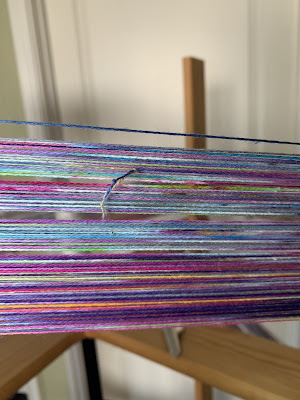



Comments